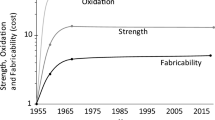Sintering peculiarities of ceramics prepared by semidry pressing were investigated. The fillers were Y2O3 and fused corundum α-Al2O3 . The binders were pure or Y- or Mg-modified alumoxane. The mechanism of sintering processes in the studied ceramic at various temperatures and its influence on the properties of the resulting ceramic were analyzed. The phase composition and thermomechanical properties of test ceramics prepared at 1500°C were studied. Prepared test ceramic crucibles had improved heat resistance and were robust to thermal cycling. The possibility of using the developed ceramic crucibles for melting and casting of chemically active and highly heat-resistant metals and alloys was discussed.





Similar content being viewed by others
References
V. V. Primachenko, V. A. Ustichenko, and S. V. Chaplyanko, “Corundum-based crucibles for induction heating of heat-proof alloys,” Ogneupory Tekh. Keram., No. 9, 9 – 12 (2007).
U. Sh. Shayakhmetov, A. R. Murzakova, and K. A. Vasin, “Fabrication of refractory ceramic crucibles,” Ogneupory Tekh. Keram., No. 10, 13 – 15 (2012).
B. A. Kulakov, V. K. Dubrovin, A. V. Karpisnskii, et al., “Evaluation of materials for ceramic crucibles for melting reactive metals and alloys,” Vestn. Yuzhno-Ural. Gos. Univ., Ser. Metall., 13(1), 51 – 55 (2013).
T. Tetsui, T. Kobayashi, T. Mori, et al., “Evaluation of yttria applicability as a crucible for induction melting of TiAl alloy,” Mater. Trans., 51(9), 1656 – 1662 (2010).
J. P. Kuang, R. A. Harding, and J. Campbell, “Investigation into refractories as crucible and mould materials for melting and casing γ-TiAl alloys,” Mater. Sci. Technol., 16, 1007 – 1016 (2000).
M. Limin, Z. Jiazhen, Y. Guangquan, et al., “Improvement and application of Y2O3 directional solidification crucible,” Chin. J. Aeronaut., 29, 554 – 559 (2015).
J. Lapin, Z. Gabalcova, and T. Pelachova, “Effect of Y2O3 crucible on contamination of directionally solidified intermetallic Ti–46Al–8Nb alloy,” Intermetallics, 19, No. 3, 396 – 403 (2011).
G. I. Shcherbakova, P. A. Storozhenko, D. V. Sidorov, et al., “Ceramics formative heteroorganic oligomers for creation of modern nanoceramocomposites,” Nanotekhnika, No. 3 (35), 15 – 23 (2013).
G. I. Shcherbaova, A. M. Tsirlin, P. A. Storozhenko, N. K. Efimov, E. K. Florina, B. I. Shamaev, and A. S. Murkina, “Method for preparing polyalkoxyalumoxanes, silica-free binding agent based on thereof,” RU Pat. 2,276,155, IPC C07F5/06, May 10, 2006, Appl. No. 2004130613/04, Oct. 21, 2004; Byull., No. 13.
R. A. Storozhenko, G. I. Shcherbakova, A. M. Tsirlin, et al., “Chelated alkoxyalumoxanes and a silica-free binder based on them,” Inorg. Mater., 43(3), 320 – 328 (2007).
G. I. Shcherbakova, P. A. Storozhenko, N. B. Kutinova, et al., “Method of producing yttrium-containing organoaluminoxanes, binding and impregnating materials based thereon,” RU Pat. 2,451,687, IPC C07F5/06, C07F5/00, May 27, 2012, Appl. No. 2011106115/04, Feb. 18, 2011; Byull., No. 15.
G. I. Shcherbakova, P. A. Storozhenko, N. B. Kutinova, et al., “Synthesis of yttrium-containing organoalumoxanes,” Inorg. Mater., 48(10), 1058 – 1063 (2012).
G. I. Shcherbakova, N. S. Krivtsova, N. B. Kutinova, et al., “Method for organomagnesium oxanaluminoxanes production, binders and impregnating materials based thereon,” RU Pat. 2,615,147, IPC C07F3/02, C07F5/068, C08G79/14, C04B35/443, Apr. 4, 2017, Appl. No. 2016108609, Mar. 10, 2016; Byull., No. 10.
T. F. Baranova, S. A. Valiakhmetov, G. V. Gogolev, et al., “Experience of using silica-free alumox binder in technology for preparing composite ceramic investment casting molds for superalloy directional solidification,” Refract. Ind. Ceram., 57(4), 335 – 341 (2016).
Acknowledgments
The work was financially supported by the RFBR under Science Project No. 17-03-00331A.
Author information
Authors and Affiliations
Corresponding author
Additional information
Translated from Novye Ogneupory, No. 6, pp. 18 – 23, June, 2018.
Rights and permissions
About this article
Cite this article
Varfolomeev, M.S., Shcherbakova, G.I. Refractory Compositions Designed for Highly Heat-Resistant Ceramic Molds in Foundry Practice. Refract Ind Ceram 59, 290–295 (2018). https://doi.org/10.1007/s11148-018-0223-3
Received:
Published:
Issue Date:
DOI: https://doi.org/10.1007/s11148-018-0223-3




